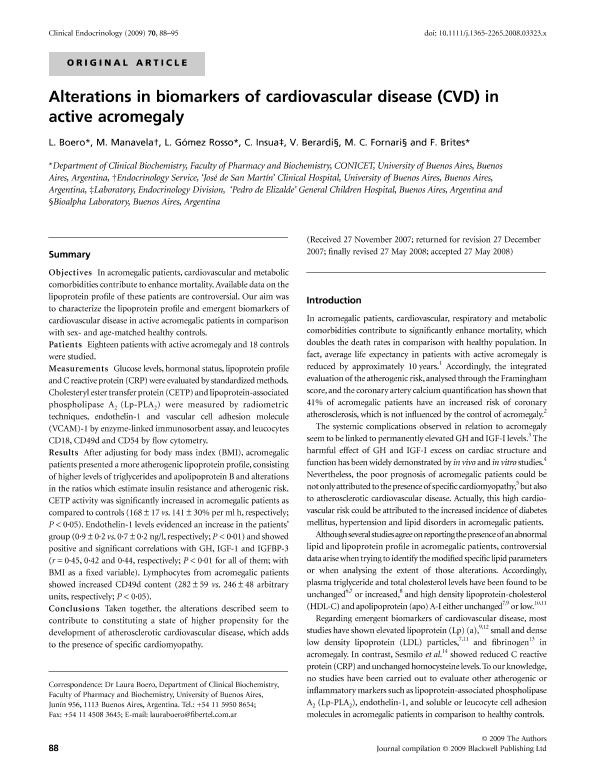Artículo
Alterations in biomarkers of cardiovascular disease (CVD) in active acromegaly
Boero, Laura Estela; Manavela, M.; Gomez Rosso, Leonardo Adrián ; Insua, C.; Berardi, V.; Fornari, M.C.; Brites, Fernando Daniel
; Insua, C.; Berardi, V.; Fornari, M.C.; Brites, Fernando Daniel
 ; Insua, C.; Berardi, V.; Fornari, M.C.; Brites, Fernando Daniel
; Insua, C.; Berardi, V.; Fornari, M.C.; Brites, Fernando Daniel
Fecha de publicación:
12/2009
Editorial:
Wiley Blackwell Publishing, Inc
Revista:
Clinical Endocrinology
ISSN:
0300-0664
Idioma:
Inglés
Tipo de recurso:
Artículo publicado
Clasificación temática:
Resumen
Objectives: In acromegalic patients, cardiovascular and metabolic comorbidities contribute to enhance mortality. Available data on the lipoprotein profile of these patients are controversial. Our aim was to characterize the lipoprotein profile and emergent biomarkers of cardiovascular disease in active acromegalic patients in comparison with sex- and age-matched healthy controls. Patients: Eighteen patients with active acromegaly and 18 controls were studied. Measurements: Glucose levels, hormonal status, lipoprotein profile and C reactive protein (CRP) were evaluated by standardized methods. Cholesteryl ester transfer protein (CETP) and lipoprotein-associated phospholipase A2 (Lp-PLA2) were measured by radiometric techniques, endothelin-1 and vascular cell adhesion molecule (VCAM)-1 by enzyme-linked immunosorbent assay, and leucocytes CD18, CD49d and CD54 by flow cytometry. Results: After adjusting for body mass index (BMI), acromegalic patients presented a more atherogenic lipoprotein profile, consisting of higher levels of triglycerides and apolipoprotein B and alterations in the ratios which estimate insulin resistance and atherogenic risk. CETP activity was significantly increased in acromegalic patients as compared to controls (168 ± 17 vs. 141 ± 30% per ml h, respectively; P < 0.05). Endothelin-1 levels evidenced an increase in the patients' group (0.9 ± 0.2 vs. 0.7 ± 0.2 ng/l, respectively; P < 0.01) and showed positive and significant correlations with GH, IGF-1 and IGFBP-3 (r = 0.45, 0.42 and 0.44, respectively; P < 0.01 for all of them; with BMI as a fixed variable). Lymphocytes from acromegalic patients showed increased CD49d content (282 ± 59 vs. 246 ± 48 arbitrary units, respectively; P < 0.05). Conclusions: Taken together, the alterations described seem to contribute to constituting a state of higher propensity for the development of atherosclerotic cardiovascular disease, which adds to the presence of specific cardiomyopathy.
Palabras clave:
ACROMEGALY
,
CARDIOVASCULAR DISEASE
,
GROWTH HORMONE
Archivos asociados
Licencia
Identificadores
Colecciones
Articulos(OCA HOUSSAY)
Articulos de OFICINA DE COORDINACION ADMINISTRATIVA HOUSSAY
Articulos de OFICINA DE COORDINACION ADMINISTRATIVA HOUSSAY
Citación
Boero, Laura Estela; Manavela, M.; Gomez Rosso, Leonardo Adrián; Insua, C.; Berardi, V.; et al.; Alterations in biomarkers of cardiovascular disease (CVD) in active acromegaly; Wiley Blackwell Publishing, Inc; Clinical Endocrinology; 70; 1; 12-2009; 88-95
Compartir
Altmétricas



